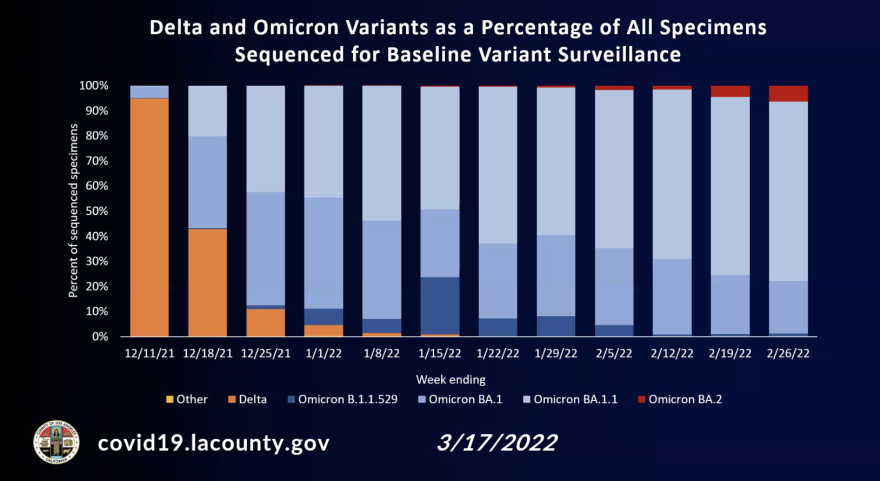Truth matters. Community matters. Your support makes both possible. LAist is one of the few places where news remains independent and free from political and corporate influence. Stand up for truth and for LAist. Make your tax-deductible donation now.
LA Health Officials Brace For Rise In ‘Stealth Omicron’ Cases

While new COVID-19 cases and hospitalizations continue to fall locally, an uptick in BA.2 omicron subvariant infections in the Northeast U.S. has Los Angeles County health officials on alert.
“Given the likelihood that BA.2 could easily become the dominant strain, we do have an opportunity to proactively prepare by maintaining our response capacity and increasing vaccination and booster coverage, particularly among those who are most vulnerable,” said Barbara Ferrer, director of the County Department of Public Health, at a media briefing on Thursday.
The average number of daily new cases reported over the past seven days in the county declined to about 950, down from about 1,100 the prior two weeks. The seven-day average daily test positivity rate also declined to slightly under 1%.
About 34 deaths are being reported each day from the virus, and 495 people are currently hospitalized with COVID-19 in the county.
L.A. County is still considered to have substantial transmission of the virus, according to the Centers for Disease Control and Prevention.
‘Stealth Omicron’ Is On The Rise
Infectious disease experts are closely watching the BA.2 subvariant of omicron, which Ferrer said appears about 30% more transmissible than the original omicron strain.
Omicron quickly crowded out delta and by January accounted for all of California’s cases. The prevalence of the BA.2 subvariant has been steadily rising over the past two weeks.
“Of the tests sequenced, 6.5% were BA.2, up from 5% last week,” Ferrer said.
Sometimes referred to as “stealth omicron” because it originally evaded scientific detection, early research suggests BA.2 spreads faster than the original omicron, which itself spread faster than the original virus and other variants. Surges in cases and hospitalizations in China and Western Europe are being fueled by the highly transmissible subvariant.
“We are closely tracking the information from Europe, since patterns seen in Britain in particular are historically seen in the United States a few weeks later,” Ferrer said.
On Tuesday, the CDC announced that BA.2 now makes up nearly one-quarter of new COVID-19 infections nationwide, up from one in 10 just a week ago.
The Northeast accounts for the highest concentration of the subvariant, with 38% of all sequenced cases in the last week. It’s also on the rise in the Southwest. According to CDC data that breaks down the country by region, the variant now makes up 27% of all sequenced tests in California, Arizona and Nevada.
The California Department of Public Health does not differentiate between the original omicron variant BA.1 and subvariant BA.2, instead grouping all the cases together under "omicron" on the publicly available data.
Ferrer expects BA.2 to become dominant in L.A., but doesn’t know how quickly that will happen.
“We're going to continue to see increases in BA.2 because it’s more infectious than BA.1. The best protection we all have is more people vaccinated, more people boosted, [which means] less places for either subvariant to thrive,” she said.
About 75% of people over the age of 5 are fully vaccinated in L.A. County, but booster uptake has been much lower.
The rollback of mitigation strategies such as mandatory mask policies may be part of the reason for the rise in cases in Europe, Ferrer said.
As of March 11, masks are no longer required in childcare or in schools in L.A. County, while the indoor public mask mandate was shed countywide on March 4. Ferrer urged people to continue to wear masks indoors, especially those who have not been vaccinated or boosted, or who are considered high risk.
No one really knows whether infection with BA.1 offers protection from BA.2, though COVID-19 antiviral pills appear to remain effective at treating stealth omicron infections, Ferrer said.
The two COVID-19 treatment pill options that are currently authorized by the FDA — Paxlovid from Pfizer and molnupiravir from Merck and Ridgeback Pharmaceuticals — are available at some pharmacies in the county with a prescription. The pills are antivirals, which means they stop the virus from making copies of itself in the body.
Paxlovid (available for anyone 12 and older weighing more than 88 pounds) and molnupiravir (available for adults 18 and older) are oral therapeutics that must be taken within five days of the first COVID-19 symptoms, and require a prescription from a healthcare provider.
Pfizer's Paxlovid is considered highly effective, reducing the risk of hospitalization by nearly 90%, but it can interfere with many commonly prescribed drugs and cause health problems if the dosages aren't adjusted. Merck's molnupiravir is less effective — cutting the risk of severe COVID-19 by around 30%, according to data reviewed by the FDA — and it comes with reproductive risks.
Most pharmacies don't have them because supplies are limited. To date, Public Health has distributed 20,960 doses of Paxlovid and 39,764 doses of molnupiravir. Since the county began receiving therapeutics, Ferrer said “73% of Paxlovid doses and 82% of molnupiravir doses have been allocated to providers in the most under-resourced communities.”







